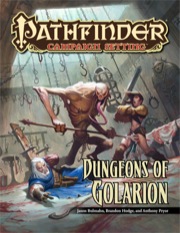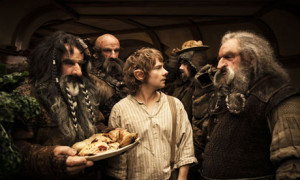 The Iron Tavern recently received an early release copy of In the Prison of the Squid Sorcerer from Mystic Bull Games. The book comes in around 44 pages not including license information and is written by Ken Jelinek, Daniel Bishop, John Humphrey, Jon Wilson, and Paul Wolfe. The book is a collection of short encounters, 12 in total, designed to be easily dropped into an existing Dungeon Crawl Classics RPG campaign. Each encounter comes with a map and a new creature. The book is available in PDF format at RPGNow. I believe a print-on-demand version is in the works.
The Iron Tavern recently received an early release copy of In the Prison of the Squid Sorcerer from Mystic Bull Games. The book comes in around 44 pages not including license information and is written by Ken Jelinek, Daniel Bishop, John Humphrey, Jon Wilson, and Paul Wolfe. The book is a collection of short encounters, 12 in total, designed to be easily dropped into an existing Dungeon Crawl Classics RPG campaign. Each encounter comes with a map and a new creature. The book is available in PDF format at RPGNow. I believe a print-on-demand version is in the works.
Most of the adventures are 2-4 pages in length and can be played in a single session. A couple of the adventures are actually designed to have portions “sprinkled” in over a longer period of time. This style lends itself well to being used to add detail to existing campaigns. Filler for between the major plot points of a campaign that help a campaign feel like there are always things going on in the world.
The level ranges covered tend to be low-level to mid-level, though a couple of the adventures are suitable for any level. From what I have seen from my various social media circles the low to mid-level focus should cover a lot of the already running DCC RPG campaigns.
The adventures within do an exemplary job of hitting the Appendix N feel. Extra-dimensional imprisonments, time shifting, alternate realities bleeding through to the known world, and fantastical creatures all contribute to unique feeling adventures. The many threats contained with this book are sure to torment your players and keep them on their toes.
For the judge, the adventures are just the right size to drop into existing campaigns as noted above. Several adventures can make good side treks for adventurers on the road or passing through small villages. Others work well for adventurers operating from a city as the base of their operations.
A map is included for most of the adventures. The one’s that do not are not tied to any one particular location, so a map is not required or applicable. The maps are done by John Humphrey and are often isometric in style. I always enjoy isometric style maps and it is nice to see this style in this book.
Black and white art fills the interior of the book accompanying each adventure.
Even if an adventure does not quite fit in with your campaign, there are numerous bits ripe for plundering from the book. Unique creatures, new cults, or even maps that could be re-worked with your own story. There is certainly something a judge of a DCC RPG campaign can “borrow” for their own campaign.
Normally when reviewing an adventure module I try to provide some detail about the adventure itself without giving too much away. Given the shorter nature of the adventures in this book, I am hesitant to detail too much about each adventure. As I noted above, the very strong Appendix N feel of each adventure within makes it a perfect choice for DCC RPG judges.
I really like the nature of a book that has many smaller encounters or adventures for me to use. All too often I pick up a module, which may be great, but just doesn’t fit into my campaign well. Either the subject matter doesn’t fit in or it is simply for a level range not appropriate for my campaign.
With this book, I already have plans to work several of the adventures into my existing campaign. The adventures make it very easy to drop-in as the group heads from place to place or while they are hanging out in their base city of operations. Products like this help make my job as a DCC RPG judge easier by providing these easy hooks for adventures. In addition there are several monsters and possible patrons I can “borrow” for my own campaign, even from the adventures I might not run in this current campaign.
This is a very strong offering from Mystic Bull Games for the Dungeon Crawl Classics RPG. I definitely encourage DCC RPG judges to check In the Prison of the Squid Sorcerer out. I suspect you will find use for several of the adventures within. Even if you choose not to use an adventure as written, there is sure to be creatures, maps, magic items and more you can make use of in your game.
















